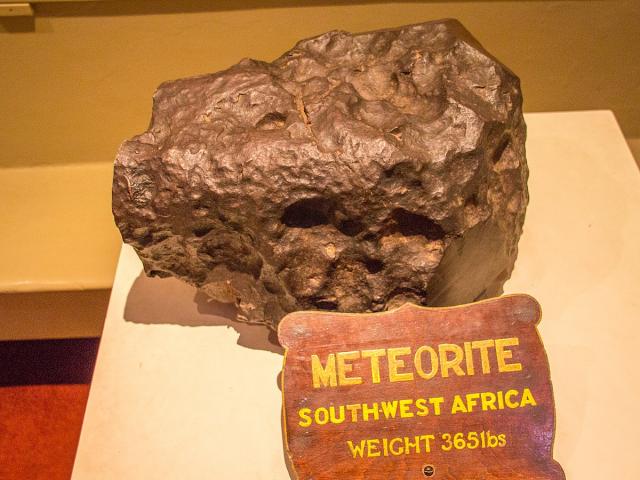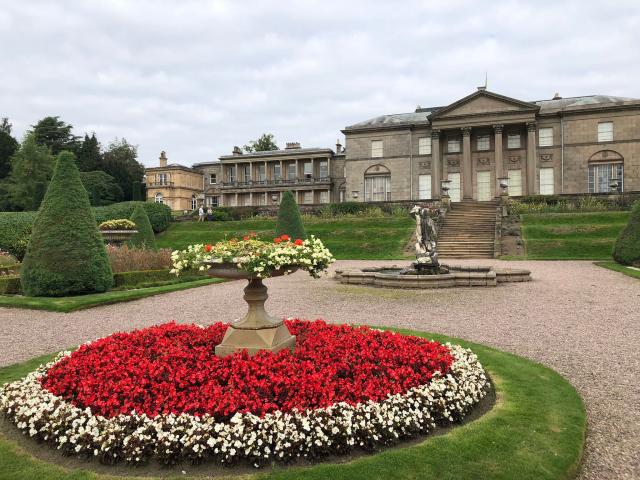- This topic has 11 replies, 7 voices, and was last updated 4 years, 3 months ago by
 Jeremy Shears.
Jeremy Shears.
-
AuthorPosts
-
10 September 2021 at 3:07 pm #575043
 Jeremy ShearsParticipant
Jeremy ShearsParticipantLast week-end I visited Tatton Park, a National Trust Property near Knutsford in Cheshire. The last owner was Maurice Egerton (1874 –1958) who was the fourth Baron Egerton. Maurice was known as an aviation and motor car enthusiast, a friend to the Wright brothers. He was issued with only the 11th pilot’s licence in Britain. He also travelled the world extensively and owned property and farms in Kenya. He displayed at Tatton Park objects he collected from his travels. Many of these can be viewed today.
One such exhibit on display is a meteorite he obtained in South West Africa. It was originally thought to be part of the Hoba West meteorite, but this was later found not to be correct.
Might anyone have any information about this meteorite, including any investigations regarding in provenance? I have been touch with the person that curated the Maurice Egerton collection at Tatton as part of her PhD studies, but she has no further information.

Photograph by Mike Peel (www.mikepeel.net). Wiki commons CC-BY-SA-4.0
Attachments:
10 September 2021 at 3:17 pm #584660 Richard MilesParticipant
Richard MilesParticipantHello there Jeremy – I don’t have an answer but I see the photo is by a certain Mike Peel.
A chap of the same name used to be a BAA and VSS member. Is this the same MP, and has he rejoined if so I would be very pleased to know that. Mike used to live in Lancashire.
Might you try and contact the photographer to see if he has anymore info.
Richard
10 September 2021 at 4:39 pm #584661 Mr Leonard EntwisleParticipant
Mr Leonard EntwisleParticipantThe Natural History Museum may hold some information in this compendium https://www.nhm.ac.uk/our-science/data/metcat/ .Looks like a printed edition plus CDs.
This too could be of use
Special Publication (No. 256) (The History of Meteoritics and Key Meteorite Collections: Fireballs, Falls and Finds)by G. J. H. McCall, A. J Bowden, et al. | 1 May 2006Neither of these are in my book mountain ,10 September 2021 at 7:23 pm #584662 Nick JamesParticipant
Nick JamesParticipantThe summary on the National Trust collections page is “interesting”. Next time a nearby supernova goes off we clearly need to go around wearing hard hats.
10 September 2021 at 7:38 pm #584663 Nick JamesParticipant
Nick JamesParticipantA link to Mike’s blog in in Jeremy’s post. That contains his bio and contact details.
10 September 2021 at 9:13 pm #584664 Alex PrattParticipant
Alex PrattParticipantHi Nick,
So if Betelgeuse ever goes bang we’ll have to look out for alpha Orionid meteorites… 🙂
Alex.
10 September 2021 at 10:13 pm #584665 Richard MilesParticipant
Richard MilesParticipantLen – Thanks for that – Alan Bowden, one of the named authors is an old friend of mine – I could follow it up with him.
11 September 2021 at 12:47 am #584666David C Rayment
ParticipantBelfast Telegraph Sat Feb 12 1938
“… in the desert limestone east of Gibeon [Namibia] is a whole valley simply peppered with small meteors. Some 40 or 50 have been dug up and are preserved at Windhoek where they have been made into a rockery in the public park”.
There is also a piece on Wikipedia: “Gibeon (meteorite)”.
There is a sample of the Gibeon meteorite in the meteorite collection of the Natural History Museum(BM): iron, Octahedrite. Date 1836. According to Wikipedia Captain J E Alexander collected samples and sent them to London where they were examined by John Herschel. Perhaps that’s where the NHM sample came from ? Herschel was a friend of John George Children, the father of Anna Atkins and assistant keeper of the Natural History Department of the British Museum.
12 September 2021 at 11:51 pm #584669 Denis BuczynskiParticipant
Denis BuczynskiParticipantHi Richard, I am sure that this Mike Peel is not the Mike Peel you are referrring to. I knew Mike Peel well, he was the Science librarian at the University of Central Lancashire and a variable star observer who made photoelectric measures with an IP21 photometer (you will remember those devices I expect!) with his home built 8 inch reflector. His main interest was in T Cor Bor using period analysis to try and to find when its outbursts would occur. He is much older than the astronomer in the link in Jeremy’s post, he will be in his 70’s I expect now.I hope this helps and brings to mind a past member who was very active within the VSS in the 1970-80s.
13 September 2021 at 12:37 am #584670 Denis BuczynskiParticipant
Denis BuczynskiParticipantHi Jeremy Looking at the Catalogue of Meteorites by G.T.Prior and Max Hay 1953 (Harold Ridley book) I see that the Gibeon Meteorite fell in SW Africa at Great Namaqualand and the finds are well documented in this book pages 131 and 132. Many large and small masses were found over wide area and 51 large masses over 15 tons have been recovered. These specimens have found between 1838 and 1910. So it is likely that the specimen you saw at Tatton Park could well be one of those.It was classified as Iron fine octahedrite. A 1.5 lb piece was sold at Christies in February 2021 for 12.500 dollars, So the 325 lb specimen at Tatton must worth a few quid! Christies gives this description :
Details
Like most iron meteorites, Gibeon meteorites formed 4.5 billion years ago within the molten core of an asteroid whose shattered remains are part of the asteroid belt. After wandering through interplanetary space, several thousand years ago the Gibeon mass slammed into Earth’s atmosphere where it exploded and rained down over what is now the Kalahari Desert in Namibia. In previous generations, indigenous tribesmen recovered small meteorite fragments at or near the surface and fashioned them into spear points and other tools. This specimen was recovered with the aid of a metal detector. Gibeon meteorites were not known to westerners until 1836. They formed deep in the iron core of an asteroid that resided between Mars and Jupiter.13 September 2021 at 11:48 am #584672 Jeremy ShearsParticipant
Jeremy ShearsParticipantMany thanks to everyone who replied.
Certainly worth having a look at the Egerton exhibition if anyone is visiting Tatton Park. Maurice Egerton was a fascinating character, interested in so many different things. I asked the curator if she had seen anything about an interest in astronomy or telescopes during her PhD research, but she has not come across anything.Certainly a place to visit for a grand day out.
 17 September 2021 at 1:34 pm #584685
17 September 2021 at 1:34 pm #584685 Jeremy ShearsParticipant
Jeremy ShearsParticipantindeed you are correct: it’s a different Mike Peel, Denis. I’ve been in touch with the MP who took the pic of the meteorite, although he has no further light to shed on the exhibit.
-
AuthorPosts
- You must be logged in to reply to this topic.
